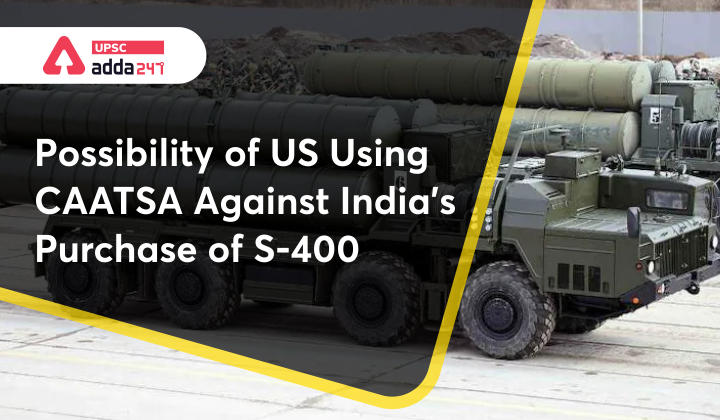”GS Paper – 2: Effect of Policies & Politics of Countries on India’s Interests”
Why in News?
India is preparing for the arrival of the $5.4-billion Russian long-range surface-to-air missile defence shield “S-400”, next month, which is likely to generate more international headlines.
What is India’s Concern?
The delivery of the five S-400 systems is considered a “significant transaction” under the USA’s Countering America’s Adversaries Through Sanctions Act (CAATSA) of 2017, which could trigger sanctions against Indian officials and the Government.
About CAATSA?
- The sanctions under it are unilateral, and not part of any United Nations decision, and therefore no country is bound to accept them.
- Its Section 231 says the President shall impose no fewer than five different sanctions on any Government that enters into a significant defence or intelligence deal with the Russian Government.
- Section 235 lists 12 options, including stopping credit lines from the U.S. and international banks such as the IMF, blocking sales of licensed goods and technology, banning banks, manufacturers and suppliers, property transactions and even financial and visa sanctions on specific officials.
- However, the law empowers the President to waive sanctions or delay them if he/she certifies that the deal is not a threat to the U.S. and allies, that waiver of sanctions is in the U.S.’s “vital national security interests” or that the country being sanctioned promises to reduce its future dependence on the “adversary country”.
Has the U.S. used CAATSA before for S-400 sales?
- The U.S. has already placed sanctions on China and Turkey for the purchase of the S-400.
- Biden administration may consider a special waiver for India, given India’s importance as a defence partner, and as a strategic partner on U.S. concerns over China and in the Quad.
- Saudi Arabia has also reportedly negotiated with Russia for the S-400, and some experts in the U.S. feel that giving a waiver to India would be the wrong signal for others seeking to go ahead with similar deals.
Why is the S-400 deal so important to India?
- S-400 is very important for India’s national security considerations, especially as it faces new threats from China, Pakistan and Afghanistan.
- The system will also offset the air defence capability gaps due to the IAF’s dwindling fighter squadron strength.
- Integrating the S-400 into the national air defence architecture will be much easier as India has a large number of legacy Russian air defence systems, a major reason India did not consider the U.S. air defence systems as a viable alternative.
- For both political as well as operational reasons, the deal is at a point of no return.
- So, it will definitely be a “game-changer”
What is India’s position?
- India has not backed down in the face of U.S. opposition thus far and is scheduled to receive the first S-400 deliveries in December.
- In preparation for the induction, two teams of technicians from the Indian Air Force were trained on the system by the manufacturer, Almaz Antey, in Russia this year.
- India will do what it has to do and is necessary for India to preserve and protect its national security interests.
In addition, buying the S-400 is a way for the present Government to assert its ‘strategic autonomy.’



 TSPSC Group 1 Question Paper 2024, Downl...
TSPSC Group 1 Question Paper 2024, Downl...
 TSPSC Group 1 Answer key 2024 Out, Downl...
TSPSC Group 1 Answer key 2024 Out, Downl...
 UPSC Prelims 2024 Question Paper, Downlo...
UPSC Prelims 2024 Question Paper, Downlo...




